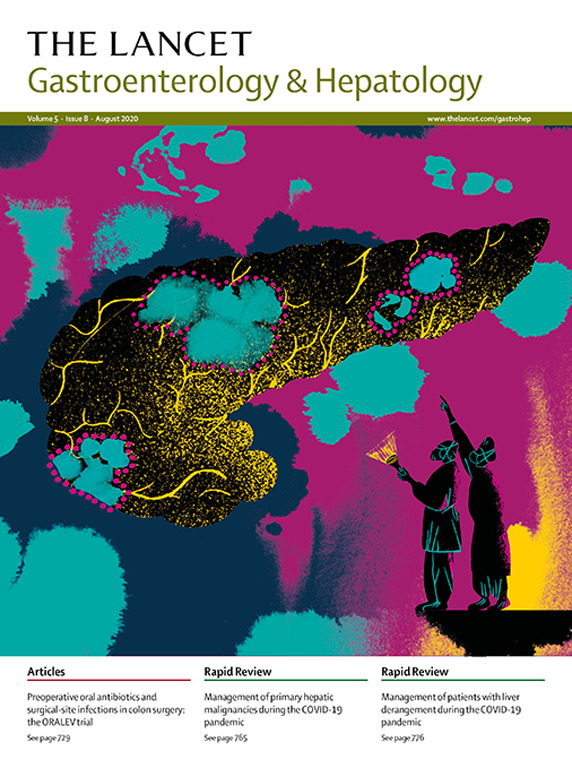Safety of artificial intelligence-assisted optical diagnosis for leaving colorectal polyps in situ during colonoscopy (PRACTICE): a non-inferiority, randomised controlled trial
IF 38.6
1区 医学
Q1 GASTROENTEROLOGY & HEPATOLOGY
引用次数: 0
Abstract
Background
Guidelines recommend leaving in situ rectosigmoid polyps diagnosed during colonoscopy that are 5 mm or smaller if the endoscopist optically predicts them to be non-neoplastic. However, no randomised controlled trial has been done to examine the efficacy and safety of this strategy.Methods
This open-label, multicentre, non-inferiority, randomised controlled trial enrolled adults age 18 years or older undergoing colonoscopy for screening, surveillance, or clinical indications across four Italian centres. Eligible patients were randomised 1:1 (with stratification by patient sex, age, and previous adenoma removal) via a central web-based system, to either the leave-in-situ group, in which endoscopists could leave non-neoplastic lesions in place after optical diagnosis, or the resect-all group, in which all detected polyps were systematically removed, regardless of optical diagnosis. Patients and endoscopists were not masked to group allocation but pathologists and investigators assessing outcomes were masked. All procedures in both groups were done with the assistance of a computer-aided detection and diagnosis system. Endoscopists optically diagnosed lesions through a combination of white light, blue light, and computer-aided detection. The primary outcome was the adenoma detection rate (ADR), defined as the proportion of participants with at least one adenoma detected (per-patient analysis), assessed by intention-to-treat, to determine whether the leave-in-situ strategy was non-inferior to the resect-all approach, with an absolute 10% non-inferiority margin. This trial was registered with ClinicalTrials.gov (NCT05500248) and is completed.Findings
Between Oct 1, 2022, and April 30, 2024, 1147 patients were recruited and 895 patients (507 [57%] females, 388 [43%] males, mean age 61·1 years [SD 9·8]) were randomly assigned to either the leave-in-situ group (n=441) or resect-all group (n=454). 197 adenomas or colorectal cancers were detected in the leave-in-situ group and 211 in the resect-all group; the ADR was 44·7% (95% CI 40·4 to 49·5) in the leave-in-situ group and 46·5% (41·8 to 51·2) in the resect-all group (absolute difference –1·8 percentage points, 95% CI –8·9 to 4·9; pnon-inferiority=0·013). No colonoscopy-related complications, including perforation and bleeding, were reported in either group.Interpretation
The leave-in-situ strategy through optical diagnosis with computer-assisted diagnosis support does not reduce oncological safety of colonoscopy, as measured by ADR. By reducing unnecessary polypectomies, this strategy could be considered as an attractive option in colonoscopy practice.Funding
European Society of Gastrointestinal Endoscopy.结肠镜检查中人工智能辅助光学诊断结肠直肠息肉的安全性(PRACTICE):一项非劣效性随机对照试验
背景:指南建议在结肠镜检查中诊断的直肠乙状结肠息肉,如果内窥镜医师光学预测它们是非肿瘤性的,则保留5mm或更小的息肉。然而,尚无随机对照试验来检验该策略的有效性和安全性。方法:这项开放标签、多中心、非自卑、随机对照试验在意大利的四个中心招募了18岁或以上的成年人,他们正在接受结肠镜检查,以进行筛查、监测或临床适应症。通过中央网络系统将符合条件的患者按1:1随机分组(按患者性别、年龄和既往腺瘤切除情况分层),分为留置组(内镜医生在光学诊断后可以将非肿瘤性病变留在原位)和全切除组(无论光学诊断如何,所有检测到的息肉都被系统切除)。患者和内窥镜医师没有被掩盖分组分配,但病理学家和研究人员评估结果被掩盖。两组的所有手术均在计算机辅助检测和诊断系统的协助下完成。内窥镜医师通过结合白光、蓝光和计算机辅助检测来光学诊断病变。主要结局是腺瘤检出率(ADR),定义为至少检测到一个腺瘤的参与者的比例(每个患者分析),通过意向治疗评估,以确定留原位策略是否优于全部切除方法,绝对非劣效性为10%。该试验已在ClinicalTrials.gov注册(NCT05500248)并已完成。结果:在2022年10月1日至2024年4月30日期间,共招募了1147例患者,其中895例患者(507例[57%]女性,388例[43%]男性,平均年龄61.1岁[SD 9.8])被随机分为离开原位组(n=441)和全部切除组(n=454)。留原位组检测到腺瘤或结直肠癌197例,全切除组211例;留置组不良反应为44.7% (95% CI 40.4 ~ 49.5),全切除组为46.5%(41.8 ~ 51.2)(绝对差异为- 1.8个百分点,95% CI - 8.9 ~ 4.9;非劣效性= 0.013)。两组均无结肠镜相关并发症,包括穿孔和出血。通过光学诊断和计算机辅助诊断支持的离开原位策略不会降低结肠镜检查的肿瘤安全性,以不良反应来衡量。通过减少不必要的息肉切除术,该策略可以被认为是结肠镜检查实践中一个有吸引力的选择。资助欧洲胃肠内窥镜学会。
本文章由计算机程序翻译,如有差异,请以英文原文为准。
求助全文
约1分钟内获得全文
求助全文
来源期刊

Lancet Gastroenterology & Hepatology
Medicine-Hepatology
CiteScore
50.30
自引率
1.10%
发文量
0
期刊介绍:
The Lancet Gastroenterology & Hepatology is an authoritative forum for key opinion leaders across medicine, government, and health systems to influence clinical practice, explore global policy, and inform constructive, positive change worldwide.
The Lancet Gastroenterology & Hepatology publishes papers that reflect the rich variety of ongoing clinical research in these fields, especially in the areas of inflammatory bowel diseases, NAFLD and NASH, functional gastrointestinal disorders, digestive cancers, and viral hepatitis.
 求助内容:
求助内容: 应助结果提醒方式:
应助结果提醒方式:


